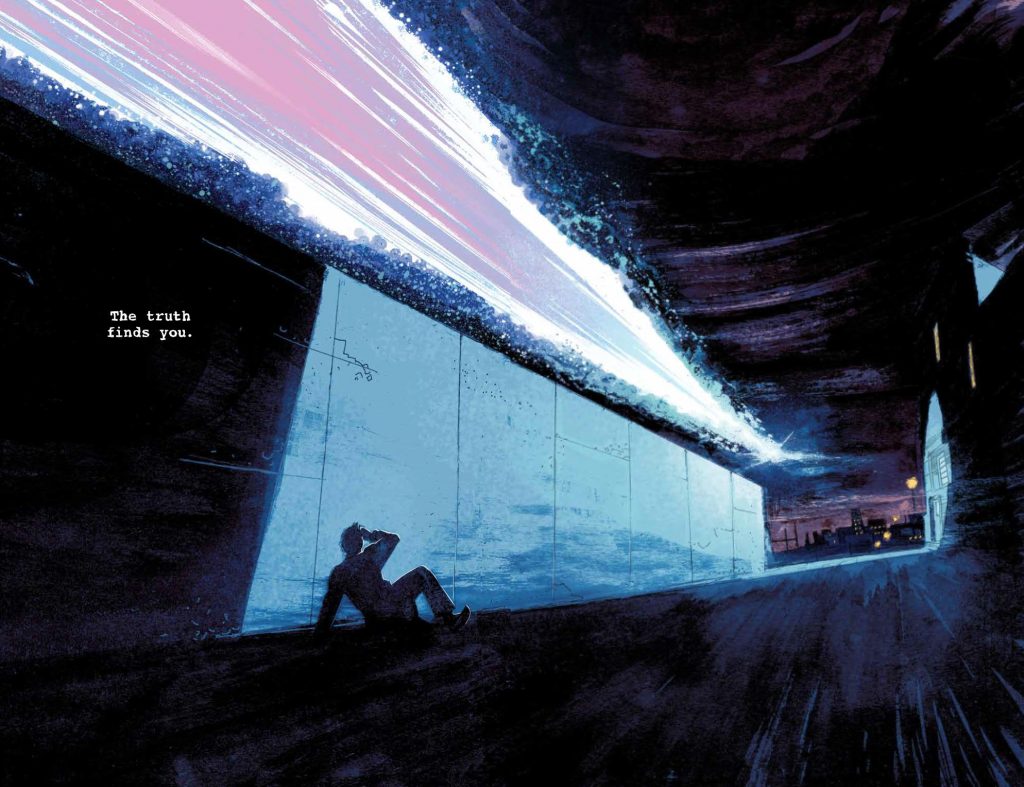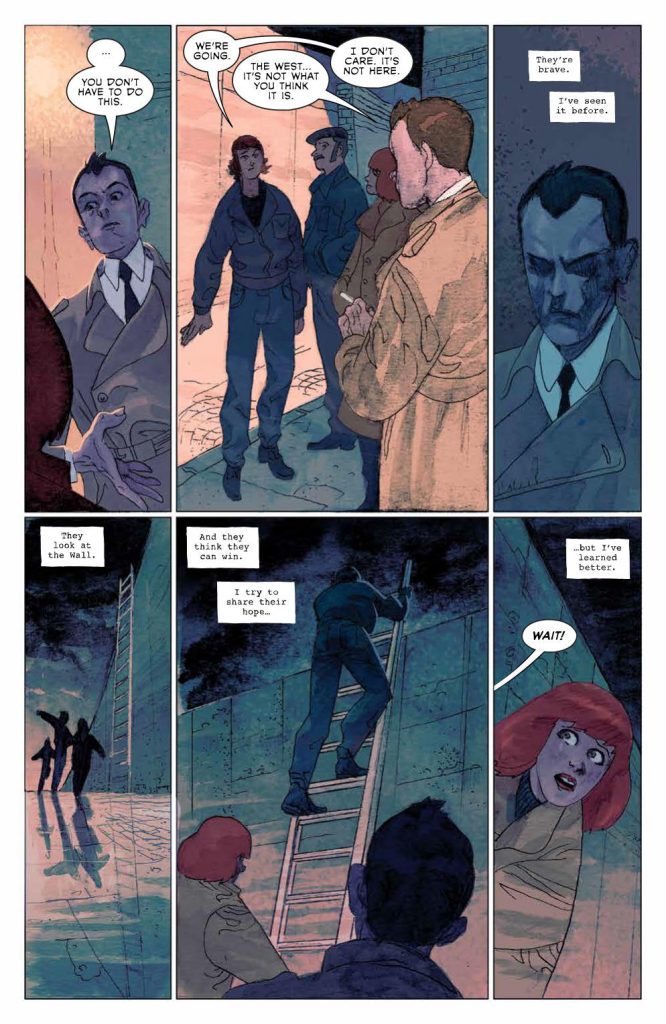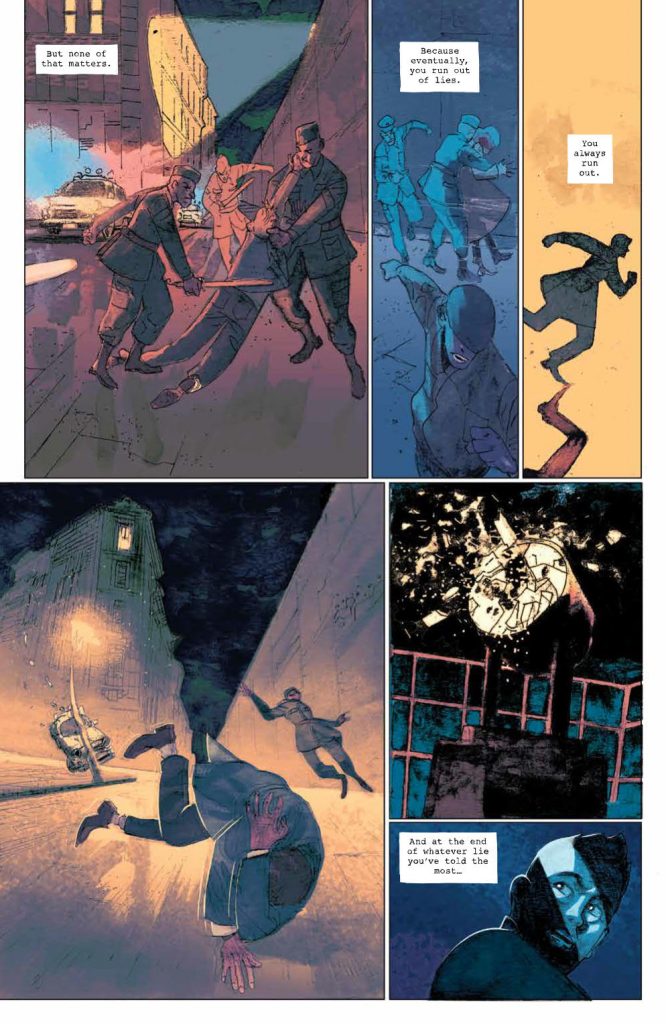
Strange Skies Over East Berlin #1
Publisher: BOOM! Studios
Writer: Jeff Loveness
Artist: Lisandro Estherren
Colorist: Patricio Delpeche
Letterer: Steve Wands
Cover Artist: Evan Cagle
Price: $3.99
Available: October 2, 2019
Out this week from Boom! Studios is the first issue of Strange Skies Over East Berlin, a period Cold War-spy games-science fiction mashup set in early 1970’s East Berlin. The United States, having just made a mess of Vietnam and struggling with its own identity, is anxiously monitoring the machinations of the Red Threat and the little ball of hate that was the Eastern Bloc. Anxiety is a constant, and the threat of World War III, of nuclear Armageddon, always looms.
Enter a gentleman answering to the moniker “Herring,” an American double-agent inserted into the East German Stasi (secret police, for those who didn’t pay attention in World History or haven’t delved into the old spy flicks of the ‘60’s and ‘70’s) at a time when no one could trust anyone, and everyone could trust no one. As one of the few remaining successful (read: living) spies on the wrong side of the Wall, Herring is constantly on guard, constantly at risk of being exposed by the uber-paranoid “peers” he is immersed with, who are led by the double-agent-sniffing, all-knowing, wolf-in-human uniform, Keiner.
As the tale opens, Herring’s had it. He’s played the game so long, so well, that he’s losing track of who he is. The lies have become reality, the truth lost to some vague and clouded history in someone else’s memory. He wants out.
His government could care less.
Especially after It happens. It being a streaking light, and massive crash in the suburbs of East Berlin that has all of the major players—the Germans, the Russians, the Brits and the Americans—scrambling for information. An attack from the West? A new weapon from the East? No one seems to know.
“One more assignment. Find this one for us, and you’re done,” is the bill of goods Herring is sold, though he’s a reluctant and uncertain buyer at best. The truth, though, is that he doesn’t have much of a choice. The world depends on him. Lose this, and we lose everything. It’s all a game of poker, and the ante is the world. You get the picture.
The truth. There’s the crux of the whole shebang. And everyone—the East and the West—are about to find out the lies they’ve been telling, the truths they’ve been hiding, have not gone unnoticed by forces they never even knew existed. And they’re about to get exposed.

The first issue of any series is about setting the tone, inviting the reader into the story’s mythology and placing it in a time and space in the reader’s mind. It’s a tricky task, without doubt. Hammer the audience with too much info, and it gets bogged down and boring; you’ll lose them by page five. Don’t give enough setting and atmosphere, and the book comes off as vague and disoriented, the story untethered. Spend too much on character development, and folks lose any sense of the story itself, but don’t provide enough and the reader can’t connect. And if the art doesn’t match the setting, the style, the oeuvre of the script…well, you’re done before you’ve even started.
Strange Skies is a great example of how to do it right. Loveness crafts an engaging tale that drops the reader right into the mindset of the Cold War. This isn’t just looking at that time through a snow globe or a YouTube video—this is placing you squarely into the mind of one of its players, paranoia and double-talk (and thought) and all. The sci fi part is a slow boil, as it should be: people of that era weren’t looking at space and alternate dimensions for their enemies and monsters, they were looking at the other side of a big, concrete wall. Herring only gradually becomes are that there’s a larger, potentially more sinister force at play. That our spy games, and the import we project on them, are tiddlywinks compared to what’s to come. All of this is constructed via the thoughts and speech—spare and dark—of our lead. Much of the script is conveyed through the pencils and colors.

And let me tell you, Estherren and Delpeche nail it. The style perfectly captures the era: Estehrren’s lines are never fully straight, always twitchy and bent. You can’t look at it and not feel nervous, that something is just a little off. And there are so many, many lines. Delpeche’s colors are constantly mottled and deepened in shadow; the hues are browns and grays and drab greens—even without the line, you feel early ‘70’s Berlin. The smoke and fog. The menace. It’s beautifully functional art: attractive to the eye on its own, but absolutely scoring the atmosphere and threat that Loveness writes.

Strange Skies is a deceptively slow read. Despite the relative paucity of verbiage, the content and art force you to digest this one slowly. It’s one of those books that you look back, having read it, and wonder how they accomplished so much in 23 pages. Then, you’ll be in a bit of shock that it was in fact only 23 pages. Felt more like 50, to me.
And that’s a good thing.
Strange Skies Over East Berlin #1 is a compelling inception into what promises to be a shadowy, lie-infested, anxiety-riddled and life-as-we-know-it threatening take on a time thankfully long-past.
And that’s a very, very good thing.
Review by Andy Patch, thePullbox.com